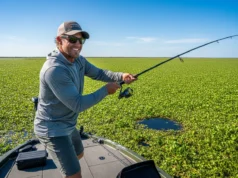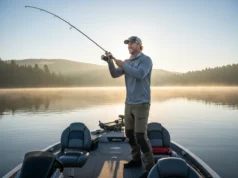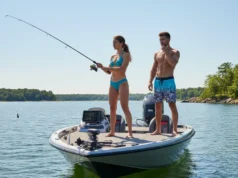In this article
The river current is relentless, and the wind on the water doesn’t care about the price tag on your fly rod. Standing in a stream casting a graphite rod can feel chaotic, a feeling I know well from decades of guiding novice fly anglers who step into the water for the first time. But fly fishing is simply applied physics and biology.
It is not a mystical art reserved for the elite. It is a mechanical system of energy transfer and a biological study of predation. By understanding the lever, the fly line, and the aquatic insect, you transform confusion into wilderness instinct. In this beginner’s guide to fly fishing, we will move past the marketing noise to focus on the hardware physics, rigging roadmap, and field logistics necessary to make you an aspirational fly angler on day one.
What Gear Do I Actually Need to Start? (Hardware Acquisition)
Why is Rod Action Critical for Learning?
For a beginner fly fisherman, the most critical specification of a fly rod is not its brand, but its “action.” Rod action defines the flexibility profile of the blank. Specifically, it tells you where the rod bends when placed under load during a fly cast.
A “medium” or “moderate” action rod is the pedagogical standard for beginners because it flexes deep into the mid-section. This flexibility provides “tactile feedback,” allowing you to physically feel the weight of the loading the rod. This sensation is essential for learning the timing of the cast. Without feeling the rod load, you are essentially guessing when to change direction.
In contrast, fast action rods are stiff and unforgiving. While marketed as high-performance tools for generating tight loops in wind, they often mask the sensation of the rod loading. This leads to timing errors for novices who cannot yet generate the high line speeds these rods require.
A helpful basic fishing equipment guide by the U.S. Fish and Wildlife Service corroborates that starting with manageable gear is key to avoiding frustration. While fast action rods have their place in saltwater fly fishing or wind, they often slow the learning curve for trout fishing. For a detailed comparison of models, you can read our guide on selecting a beginner fly rod and reel.
Is an Expensive Reel Necessary for Trout?
In freshwater angling, specifically for trout, the reel’s primary function is largely misunderstood. Unlike in saltwater fly fishing, where a reel is a critical fighting tool against powerful fish, a fly reel for trout is mostly a storage device for your line.
Pro-Tip: If you have a limited budget, spend 70% of it on the rod and line, and 30% on the reel. A trout will rarely pull line off the reel fast enough to burn out a cheap drag system.
Fly reels generally come in three material tiers: Die-Cast Aluminum, Composite/Polymer, and CNC Machined. Die-cast is affordable but brittle; dropping it on a rock often results in a shattered frame. Interestingly, modern composite (plastic) reels are durable “beaters” that bounce rather than break, making them excellent for the clumsy learning phase.
Understanding the materials science of aluminum alloys helps explain why machined reels cost significantly more. They are cut from a single block of aerospace-grade aluminum for maximum strength.
Beyond the material, you must consider the drag system. Classic small trout reels often use a click-and-pawl mechanism, while modern versions use a disc drag. While a smooth disc drag is nice, it is rarely engaged for average rainbow trout or brook trout. You can learn the nuances of how to set your fishing drag once you start targeting large fish. For your first fish, a functional line holder is all you need.
How Do I Connect the System? (The Rigging Roadmap)
What is the Architecture of a Fly Line Setup?
The fly fishing setup is a four-part stack: Backing -> Fly Line -> Leader -> Tippet.
- Backing: Braided line that fills the large arbor fly reel to reduce memory coils and provides extra length if a strong fish runs.
- Fly Line: The heavy, coated line that provides the mass required to cast the fly. Most beginner anglers use a floating line.
- Leader: A tapered leader (monofilament) that transitions energy from the heavy fly line to the fly.
- Tippet: The thin, terminal connection tied to the fly.
Most beginners should start with a “Weight Forward” (WF) fly line. This line places the bulk of the mass at the front, acting as the engine to deliver the overhead cast. The energy generated by the line travels down the line taper, which is thick at the butt section and thin at the end.
This taper is physically required to “turn over” the fly. If you used a level piece of fishing line, the energy would die, and the line would pile up in a heap. Understanding the differences between braided, fluorocarbon, and monofilament lines is crucial. For example, fluorocarbon tippet sinks and is invisible, making it ideal for nymphs, while nylon is better for dry flies.
The tippet serves as the “sacrificial element.” As you change fishing flies, you cut away tippet, preserving the expensive tapered leader. A trusted NPS guide to rigging fishing tackle can provide further visual context on how these components layer together via a loop-to-loop connection.
Which Knots Are Non-Negotiable?
You do not need to know twenty knots. You need to master three that act as the joints of your system.
- The Clinch Knot: Used to connect the nylon tippet to the hook eye. It is the terminal connection.
- The Double Surgeon’s Knot: The easiest and strongest knot for joining two pieces of line (tippet to leader).
- The Nail Knot: Essential if your fly line does not have a welded loop, connecting the leader to the fly line.
Knots usually fail due to “friction burn.” When you tighten a knot, the heat generated can weaken the monofilament by up to 50%. The physics of knot strength and friction dictate that lubrication is mandatory. Always wet your knot with saliva or water before cinching it down.
Additionally, adopt the “Weakest Link” strategy. Your tippet knot should always be weaker than your backing knot. If you snag a log in fishy water, you want to break off the fly, not lose your entire fly line. For step-by-step instructions, see our guide on mastering the angler’s knot matrix.
How Do I Know Which Fly to Use? (Applied Entomology)
What Are the “Big Four” Insects?
Don’t be intimidated by Latin names or fly fishing entomology. You only need to recognize the silhouettes of the “Big Four” insect orders: Mayflies, Caddisflies, Stoneflies, and Midges.
- Mayfly: The classic “sailboat.” They have upright wings and long tails. Dry fly fishing often targets these as they drift sedately.
- Caddisfly: The “tent.” Their wings fold back over their body in a V-shape. They are erratic, often skittering across the surface.
- Stonefly: The “flatliner.” They have two sets of wings that lay flat against their back. They are clumsy fliers and often crawl out on rocks rather than hatching in open water.
- Midge: The “mosquito-like” fly. Tiny dipterans that are present year-round, especially in winter on tailwaters.
When choosing a fly selection, rely on “Impressionism.” You don’t need an exact replica. You need a generalist pattern that mimics the size and silhouette. For dry flies, stock the Parachute Adams and Elk Hair Caddis. For subsurface nymphs, carry the Pheasant Tail and Hare’s Ear.
Government resources, such as the EPA aquatic insect identification keys, show the diversity of these bugs, but for the fly angler, shape is king. This is the essence of match the hatch. For a deeper look, read about identifying aquatic insects for fishing.
What Does “Day One” on the Water Look Like? (Operational Logistics)
How Should I Manage My Setup Before Hitting the Water?
Chaos control starts in the parking lot. Follow the “Rig at the Car” protocol: assemble your 4-piece rod, string the line, and attach your fly box selection in a stable environment. Trying to thread tiny guides while standing in a moving river is a recipe for dropped nippers and frustration.
When walking to the water, adhere to the “Tip Behind” rule. Always carry the rod with the fragile tip pointing behind you. If you trip—and you will—the rod tip won’t slam into the ground.
Once you are fishing, practice “Ferrule Maintenance.” Check the connections of your rod sections periodically. Vibration loosens them, and a loose section can fly off or crack during a forward cast. Finally, ensure you have safety gear; understanding why polarized sunglasses are essential goes beyond seeing brown trout—they protect your eyes from wayward barbless hooks. The recreational boating and fishing safety guidelines reinforce the importance of being prepared before you wade in with your wading boots.
What Are the Unwritten Rules of the River?
River etiquette keeps the peace. The cardinal sin of fly fishing is “Low Holing”—entering the water immediately downstream of an angler working their way up. This cuts off their future water and disrupts the feeding trout they are targeting.
Maintain a “Buffer Zone” of at least 100 to 200 feet. A fly fisherman needs room for a back cast and a forward drift. Generally, wade anglers have the right-of-way over boats, and anglers moving upstream have priority over those moving downstream.
When in doubt, communicate. A simple, “Which way are you working?” establishes a plan and builds rapport. Respecting these boundaries aligns with Leave No Trace fishing principles, ensuring everyone enjoys the resource. Once you have your spot, the next step is learning to read the river—identifying riffles, pools, and seams where fish hold.
How Can I Ensure the Fish Survives? (Ethical Stewardship)
Why Does Handling Time Matter Physiologically?
Catch and release is only effective if the fish actually survives the encounter. The “Fight” is an anaerobic activity for the fish, causing lactic acid buildup in the muscles (acidosis). If played to exhaustion, the fish may swim away but die hours later.
Air exposure is the critical variable. A fish’s gill lamellae collapse out of water, preventing oxygen exchange. Aim for zero to ten seconds of air time. We advocate for “Keep ‘Em Wet” principles: use a rubber mesh net and keep the fish submerged while removing the hook with forceps or hemostats.
Pro-Tip: Never handle a trout with dry hands. Dry skin removes the fish’s protective “slime coat” (mucus), leaving them vulnerable to fatal fungal infections.
Reviving a fish requires facing it upstream into the current. This forces oxygenated water over the gills. Do not pump the fish back and forth; this is ineffective and unnatural. The NOAA catch and release best practices provide the scientific standard for these techniques. For a comprehensive breakdown of the physiology involved, review the science of catch and release techniques.
Conclusion
Fly fishing is not about luck; it is about competence. The fly rod is simply a lever you must learn to load. The system is modular, held together by friction and physics. The insects are biological signals to be observed, not memorized. And finally, sustainable fishing is mandatory; we protect the resource so that the river remains alive.
Don’t wait for the perfect trip to Patagonia. Take your new beginner fly fishing combo to a local park or pond this weekend. Practice the overhead cast on grass where the stakes are low. When you finally step into the river, you will be ready to stop thinking about the rod and start thinking about the trout.
FAQ – Frequently Asked Questions about Beginner Fly Fishing
What weight fly rod is best for a beginner?
A 9-foot, 5-weight rod is the universal standard for freshwater angling, specifically for trout fishing and bass fishing. It offers the versatility to cast dry flies, nymphs, and small streamers effectively without being too heavy to manage.
Do I really need waders to start fly fishing?
No, you can wet wade wearing shorts and sandals in warm months or simply fish from the bank. Waders (specifically stockingfoot waders with wading boots) are only essential for cold water protection or when you need to reach deeper holding water to get a drag-free presentation.
What is the difference between a leader and a tippet?
The leader is the tapered leader attached to the fly line that transfers energy. The tippet is a level line added to the end of the leader. Tippet is sacrificial—you cut it back as you change flies, preserving the expensive leader.
How much should I spend on my first fly fishing setup?
A functional entry-level setup (Rod, Fly Reel, Line) typically costs between $150 and $200. Spending less often results in poor quality fly line that retains memory coils, making learning casting techniques significantly harder.
Risk Disclaimer: Fishing, boating, and all related outdoor activities involve inherent risks that can lead to injury. The information provided on Master Fishing Mag is for educational and informational purposes only. While we strive for accuracy, the information, techniques, and advice on gear and safety are not a substitute for your own best judgment, local knowledge, and adherence to official regulations. Fishing regulations, including seasons, size limits, and species restrictions, change frequently and vary by location. Always consult the latest official regulations from your local fish and wildlife agency before heading out. Proper handling of hooks, knives, and other sharp equipment is essential for safety. Furthermore, be aware of local fish consumption advisories. By using this website, you agree that you are solely responsible for your own safety and for complying with all applicable laws. Any reliance you place on our content is strictly at your own risk. Master Fishing Mag and its authors will not be held liable for any injury, damage, or loss sustained in connection with the use of the information herein.
Affiliate Disclosure: We are a participant in the Amazon Services LLC Associates Program, an affiliate advertising program designed to provide a means for us to earn advertising fees by advertising and linking to Amazon.com. As an Amazon Associate, we earn from qualifying purchases. We also participate in other affiliate programs and may receive a commission on products purchased through our links, at no extra cost to you. Additional terms are found in the terms of service.





